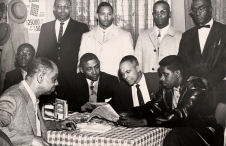Good Time Coming?: Black Nevadans in the Nineteenth Century
In 1975, Elmer Rusco (1928-2004) published Good Time Coming?: Black Nevadans in the Nineteenth Century (Westport, CN: Greenwood Press, 1975). To date, this remains the most complete and significant scholarly work on the history of 19th century African Americans in Nevada.
Rusco, a political scientist at the University of Nevada, Reno from 1963 to 1986, was a longtime advocate for civil rights, a passion that first emerged during a trip through the segregated South in the late 1940s. He participated in civil rights protests as a member of the Congress of Racial Equality (CORE) while in college, and he participated in a number of social justice causes throughout his life. One of his goals was to use his scholarship as another weapon in the fight for social justice.
Upon his arrival in Nevada in 1963, his early investigations into the status of African Americans in Nevada revealed a dearth of research into this group. His first foray into this subject resulted in Minority Groups in Nevada (Reno, NV: Bureau of Governmental Research, 1966), a brief analysis of the condition of minorities in Nevada. Although the findings were not startling—that African Americans and Native Americans in Nevada had lower per capita incomes, lower educational levels, and poorer health—it collected and made available the evidence that demonstrated these inequalities. In addition, it alerted Rusco to the lack of historical research into African Americans in the West in general and Nevada in particular. In response, Rusco began researching what would become his most significant scholarly work—Good Time Coming?: Black Nevadans in the Nineteenth Century.
In this carefully researched and argued work, Rusco uncovered a small but active group of African Americans who, like their counterparts in other parts of the country, experienced a postbellum improvement in social conditions followed by a gradual decline at the turn of the century. Rusco found that African Americans in Nevada, though small in number (never more than 500 during the 19th century), formed organizations to advocate racial justice and to protest mistreatment. Several were remarkably articulate; for example, Rusco uncovered numerous letters and speeches of Thomas Detter, a barber in eastern Nevada whose letters and speeches provide insight into perspectives of African Americans in the West (Rusco expanded his discussion of Detter in a full-length article in 2004). Another significant find was the life and work of Dr. W. H. C. Stephenson, the most prominent African American spokesman in Virginia City at the height of that city’s Comstock era. Remarkably, Good Time Coming? remains the definitive work on Nevada’s 19th century African American population a full 30 years after its initial publication. It is cited widely; for example, the definitive history of African Americans in the West, Quintard Taylor’s In Search of the Racial Frontier: African Americans in the American West, 1528-1990 (New York: W. W. Norton & Company, 1998), uses Rusco’s work as the sole source for Nevada’s African American history in the late 19th century. Yet another indication of the quality of Rusco’s work is the demand for copies of the now out-of-print book—used book sellers ask $100 or more for a copy of Good Time Coming?
Subsequently, Rusco continued researching and writing about African Americans and other minority groups in Nevada. He published articles on the civil rights movement in Hawthorne and the anti-Chinese riots in turn-of-the-century Tonopah. At the time of his death, Rusco was completing a second book-length manuscript on the history of race and the law in Nevada. In 2004, he was diagnosed with amyotrophic lateral sclerosis, also known as “Lou Gehrig’s Disease.” He succumbed to the illness six months later at age 76.
Article Locations
Related Articles
Further Reading
None at this time.




